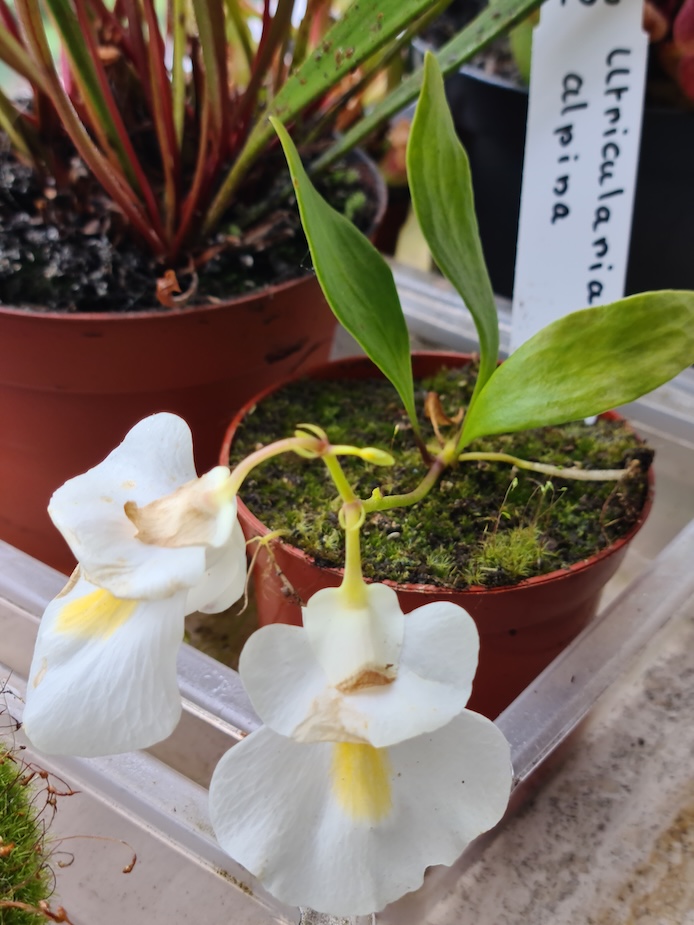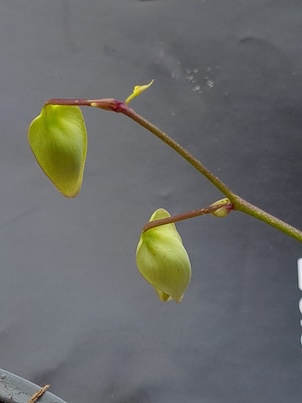

Utricularia alpina
General
Utricularia alpina is a fascinating and beautiful carnivorous plant from the family Lentibulariaceae. Native to the highland regions of the Caribbean and parts of northern South America, it is prized for both its unique trapping mechanism and its surprisingly showy flowers. This species is popular among enthusiasts for its ease of cultivation (compared to other tropical Utricularia) and for the cheerful presence it brings to any collection of unusual plants.
Physical Characteristics
This semi-terrestrial to epiphytic plant is known for its thick, fleshy leaves and sprawling rhizomes. The leaves are typically oval or oblong, smooth to the touch, and can vary in size based on growing conditions. Underneath the soil or moss surface, the plant develops specialized bladder traps (utricles) that capture tiny prey. The flowers are its showpiece—large, often white or pale lavender, with a distinct, spurred lower lip and delicate appearance that stands out among carnivorous species.
Lifestyle
Instead of capturing insects on its foliage like sundews or pitcher plants, this species relies on tiny, near-microscopic bladder traps positioned along its underground stolons. These bladders suck in minute soil-dwelling creatures—mostly protozoa and tiny invertebrates—supplying the plant with essential nutrients in its typically impoverished environments.
Habitat and Protection
In the wild, this plant is most at home in tropical montane cloud forests, growing on mossy rocks, tree roots, or in deep forest litter at elevations between 900 and 2,800 meters. Its native habitats are perpetually moist, shaded, and humus-rich, with cool temperatures compared to lowland tropics. Utricularia alpina is not considered threatened, but its cloud forest ecosystem is sensitive to deforestation and climate change, so cultivated specimens contribute to ex-situ conservation.
Cultivation
Given the right environment, this plant is quite forgiving and can even flower in the care of attentive hobbyists. Its preference for orchid-like conditions—airy, moist, and cool—makes it a good candidate for terrariums or greenhouses. With patience and the correct environment, it can reward you with spectacular flowers and lush foliage year-round.
Special Features
- Intricate, hidden bladder traps for tiny prey
- Robust, tuberous rhizomes act as reserves if the foliage dies back
- Produces some of the largest flowers in the genus
- Capable of being grown as both a terrestrial and an epiphyte
Care
Light
Bright, indirect light is ideal. Avoid harsh midday sun, which can scorch the leaves, but ensure the plant receives enough light to stimulate flowering. Early morning or filtered eastern light is excellent.
Temperature
Prefers cool to intermediate temperatures, typical of highland climates. Ideal range: 13–23°C (55–74°F). Short drops below 10°C (50°F) are tolerated if not prolonged.
Water
Keep the substrate consistently moist but not waterlogged. Use only soft, mineral-free water—rainwater, distilled, or reverse osmosis. Avoid letting the medium dry out completely.
Soil
A loose, airy mix works best. Try a blend of finely chopped sphagnum moss, perlite, and a small amount of orchid bark. Some growers succeed using pure live sphagnum. When grown epiphytically, mount it securely on a slab with sphagnum.
Nutrition
Does not require fertilizer if fed regularly by its traps, though an occasional, very dilute orchid fertilizer (at ¼ strength) can be misted onto the leaves during periods of active growth. Avoid over-fertilization—it’s easy to burn sensitive roots and impair trap function.
Humidity
Thrives best at high relative humidity—ideally 70% or higher. A terrarium or humidity tray can help; frequent misting is also beneficial in drier environments.
Dormancy
While not strictly dormant, plants may slow down or temporarily shed leaves if conditions become cooler or drier. The underground tubers will allow them to rebound when favorable conditions return. There’s no need for enforced dormancy—just let the plant’s natural rhythm guide you.
Common Problems
Foliage wilts or shrivels
Cause: Low humidity or substrate dried out.
Solution: Increase ambient humidity and water more regularly. Place the plant on a humidity tray or within a terrarium.
No flowering despite healthy foliage
Cause: Insufficient light or lack of seasonal temperature fluctuation.
Solution: Increase light exposure, or provide a brief period of cooler temperatures to simulate highland conditions.
Slow growth, yellowing leaves
Cause: Water quality issues—tap water contains minerals that accumulate in the substrate.
Solution: Use only purified or rainwater; consider repotting into fresh, mineral-free substrate.
Bladder traps turn brown and rot
Cause: Soil is too compacted or waterlogged, leading to rot.
Solution: Repot into a lighter, airier growing medium; avoid letting pots sit in stagnant water.
If you give this uncommon carnivore the gentle conditions it loves, it can thrive and astonish with its intriguing traps and orchid-like blooms.
